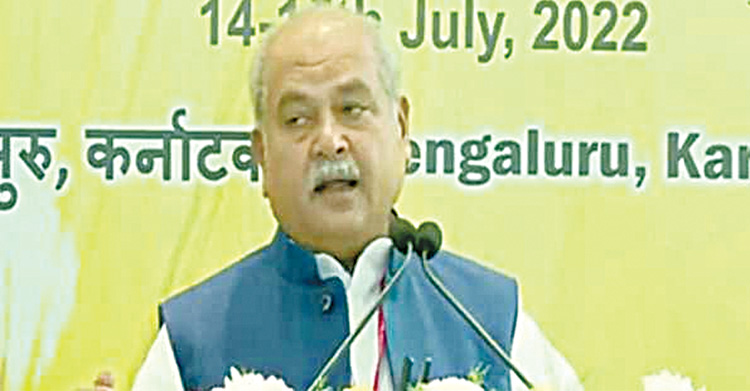Bangalore, July 15 (FN Agency) Agriculture and Farmers Welfare Minister Narendra Singh Tomar on Thursday said work needs to be done without any vested interest on how the Centre and States can bring about a change in the lives of small farmers sitting in the villages.Tomar was speaking after the inauguration of State Agriculture and Horticulture Ministers’ Conference in Bengaluru, Karnataka. He also launched the Platform of Platforms (POP) under the National Agriculture Market (e-NAM) on the sidelines of the event. Equity grant of over Rs 37 crore was also released to 1,018 Farmer Producer Organizations (FPOs) that will benefit about 3.5 lakh farmers. Those present included the Chief Minister of Karnataka Basavaraj Bommai, Union Minister of Chemicals & Fertilizers and Health & Family Welfare Mansukh Mandaviya, Union Ministers of State for Agriculture and Farmers Welfare Shobha Karandlaje and Kailash Choudhary, Agriculture Minister of Karnataka BC Patil, State Ministers, Union Agriculture Secretary Manoj Ahuja and other senior officers.
The National Conference of State Agriculture and Horticulture Ministers has been organized after two years due to the Corona crisis, in Bangalore. Addressing the Inaugural ceremony, Tomar said that the Central and State Governments are working together in the field of agriculture, yet we all bear the important responsibility to solve the challenges facing the agriculture sector, formulate policies and their proper implementation.“Our country is the largest democracy, where there is diversity of ideology, language, geography and climate, but herein lies the strength of India. There is a need to discuss how this can be used in the interest of the States and the country in the context of agriculture. Agriculture is a very sensitive sector which is connected to crores of farmers. Work needs to be done without any vested interest on how the Centre and States can bring about a change in the lives of small farmers sitting in the villages.
Prime Minister Modi has recently said that whatever is happening on the land, that should also reach the lab. This needs to be looked into because till now the focus was on ‘Lab to Land,’” he said. Tomar said that the country has to depend on the import of fertilizers and the central government is incurring a subsidy of about Rs. 2.5 lakh crore rupees annually in the interest of farmers, so that the burden of rising prices internationally does not fall on our farmers. But there must be an end to this situation at sometime, he said. “So now in the field of fertilizers also we need to be AatmaNirbhar (self-reliant), there is a need to ‘Make in India’,” said Tomar. Mandaviya, while explaining the global situation of fertilizers, said that India has to import it in large quantities, the raw material is also very expensive, and yet the central government is giving excessive subsidy. Subsidy on DAP has been hiked from Rs. 512 in 2020-21 to Rs. 2,501 for the 2022-23 Kharif season.
He said DAP price in India is lowest as compared to other countries and as per the directions of the Prime Minister, the burden of increased cost is not being passed on to the farmers and the government is committed to the easy availability of fertilizers across the country, but now there is a dire need to increase the use of nano fertilizers and undertake this as a campaign across the country. With the introduction of POP, farmers will be facilitated to sell the produce outside their state borders. This will increase farmers’ digital access to multiple markets, buyers and service providers and bring transparency in business transactions with the aim of improving price search mechanism and quality commensurate price realisation. 41 service providers from different platforms are covered under POP facilitating various value chain services like trading, quality checks, warehousing, fintech, market information, transportation etc. The PoP will create a digital ecosystem, which will benefit from the expertise of different platforms in different segments of the agricultural value chain.

